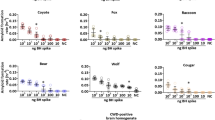
Overview
- Conventional approaches to trace migrations in wild birds requires
- expensive engagements of multiple teams
- Capturing wild waterfowl becomes increasingly difficult from animal
- Understand alternative multi-disciplinary approaches for monitoring of the highly pathogenic avian influenza in wild waterfowl
- Includes supplementary material: sn.pub/extras
Buy print copy
Tax calculation will be finalised at checkout
About this book
This manuscript discusses the potentials of the approaches as mentioned below to monitor the AIVs in WMW. Molecular diagnostic platforms enable for accurate detection of the AIVs in the feces of infected birds. Similar technologies can be used to determine the bird species through DNA barcoding, enabling non-invasive research on the epidemiology of the disease.
Wild migratory waterfowl (WMW) play significant role in the transmission of avian influenza viruses (AIVs) on large distances. Understanding bird migrations may therefore significantly contribute towards understanding of the disease epidemiology, however most conventional approaches to trace WMW migrations are based on capturing, tagging (mostly ringing or GPS devices) and their re-capturing to link the departure and arrival places.
Stable isotope ratios in metabolically inert tissues (feathers, beaks, claws) reflect the ratios present at the point of intake (drinking or feeding), thus enabling for tracing bird origins at stopover places.
Molecular diagnostic platforms such as the polymerase chain reaction
(PCR) enable for accurate detection of the AIVs in the feces of infected
birds. Similar technologies (genetic sequencing) can be used to determine the
bird species through DNA barcoding. Simple and easy collection of feather and
fecal samples at the stopover places may generate a full information package
on which species of WMW carries the AIVs (PCR+DNA barcoding on the feces), as
well as the origin of these species (SI+DNA barcoding on the feathers).
Therefore, such approaches enable for research on the epidemiology and the
ecology of the AIVs in WMW using a non-invasive platform, which does not
require capturing of WMW. This manuscript discusses the potentials of these
approaches to monitor the AIVs in WMW.
p>
Similar content being viewed by others
Keywords
Table of contents (4 chapters)
Authors and Affiliations
Bibliographic Information
Book Title: Stable Isotopes to Trace Migratory Birds and to Identify Harmful Diseases
Book Subtitle: An Introductory Guide
Authors: G.J. Viljoen, A.G. Luckins, I. Naletoski
DOI: https://doi.org/10.1007/978-3-319-28298-5
Publisher: Springer Cham
eBook Packages: Biomedical and Life Sciences, Biomedical and Life Sciences (R0)
Copyright Information: IAEA 2016
Hardcover ISBN: 978-3-319-28297-8Published: 09 August 2016
Softcover ISBN: 978-3-319-80319-7Published: 07 June 2018
eBook ISBN: 978-3-319-28298-5Published: 22 June 2016
Edition Number: 1
Number of Pages: XII, 49
Number of Illustrations: 1 b/w illustrations
Topics: Animal Ecology, Community & Population Ecology, Monitoring/Environmental Analysis



